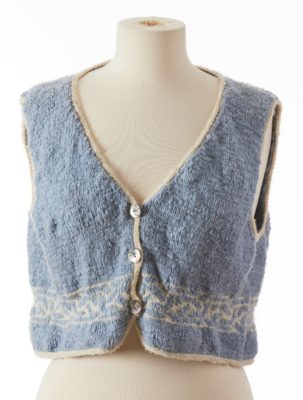My first dedicated spinning-for-garment project was a good one for learning new skills. A beautiful commercial top of merino and silk seduced me: I bought a pound and spun it into singles, set the twist, and planned to dye most of the skeins, setting aside one as an accent color in natural cream. I can no longer remember if I made the yarn first and then chose the knitting project, but that’s probably how it happened. I guarantee that I didn’t exactly plan this yarn—it just kind of happened. The slubs are visible in this yarn’s fabric with or without a light source behind it! I don’t think I made a control sample and honestly, I had no control over my spinning at this point, which was one out of many dyeing lessons I had to learn!

I was also new to dyeing, and my first experience with it taught me two crucial dyeing lessons.
Two Crucial Dyeing Lessons:
- Wool, as a protein fiber, doesn’t take dye the same way a cellulose (plant) fiber does. My then-boyfriend was an experienced dyer of cotton T-shirts, and he knew all about silkscreening, batik, dye resists, and so on. So we bought some dye and prepped my very first dyebath. Neither of us realized that protein and cellulose fibers required different dyes. We were expecting a deep purple but got a muted periwinkle.
- Wool felts if you stir it in the dyepot. Because we were using T-shirt techniques as well as T-shirt dye, we stirred a lot. You can stir a T-shirt in a dyepot until your arm falls off, with no ill effects; wool yarn, not so much. We were lucky the skeins didn't become a giant felted mass. Slubs in the yarn did get felted into permanence. And now I know that a little felting can be a design choice: we all know the commercial yarns that are deliberately felted for structure and texture.
A simple knitted vest with a contrasting motif and edgings suited this yarn very well. Probably I adapted an existing pattern and added the motif from a different design—without Ravelry to keep all my notes straight, a lot of these details are lost.

Knitting with this slubby yarn taught me another lesson: A very inconsistent yarn considerably slows down my knitting speed. Slubs and stranded colorwork also don’t make the best combo: the cream yarn got thin just when I needed it to be thick and vice versa.
For all its faults, I still love my first vest—it has a rustic, folk art look that suits the yarn. Plus, this project taught me to use acid dyes on protein fibers. Often we learn more from our “failures” than from our successes.
Next time with dyeing lessons, we’ll look at my first pair of handspun socks, which taught me an entirely different set of lessons! —Deb
P.S. Avoid my mistakes with the dyebath, and drown your yarn in breathtaking colors with Deb Menz’s classic video Dyeing in the Kitchen, and Felicia Lo’s Dyeing to Spin & Knit. These experts walk you through all the techniques and provide stunning inspiration for your own dyeing adventures.

